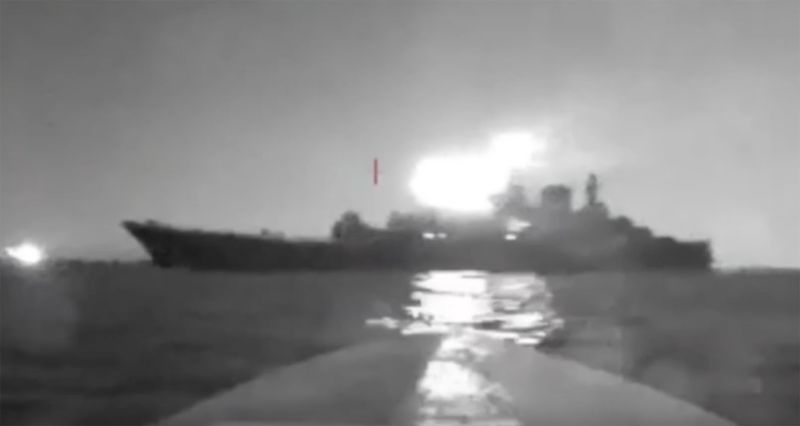Ukrainian sea drones attacked a major naval base in Russia on Friday, leaving a damaged Russian warship listing in the Black Sea in a brazen strike carried out hundreds of miles from Ukrainian-held territory.
Dramatic social media videos showed the vessel, an amphibious Russian landing ship, tilting badly and sitting very low in the water as it was being towed near the base at Novorossiysk, Russia’s largest port.
The incident comes against the backdrop of rising tensions in the Black Sea and stepped up Ukrainian strikes against targets across Russia after President Volodymr Zelensky pledged to “return” the war to Russian territory.
The Ukrainian source said the operation was carried out jointly by the Security Service of Ukraine and the Ukrainian Navy.
A Russian-appointed official said later on Friday that three Ukrainian sea drones had also been destroyed near the Kerch Strait and the area leading to the Crimean bridge.
The drones damaged a civilian Russian tanker, injuring some crew members, according to Vladimir Rogov, an official with the Zaporizhzhia military-civilian administration. However, Russia’s Federal Agency for Marine and River Transport said in a statement on Telegram that there were no casualties among the 11 crew.
SIG is one of the biggest Russian oil tankers. It was built in 2014 and has 5,000-ton capacity.
An ambitious push
The strike at Novorossiysk was the latest demonstration of Kyiv’s ambitious push to develop long-range unmanned attack vehicles at sea and in the air. The drone that hit the ship would have had to travel several hundred miles to reach the port, whether launched from Ukrainian-controlled territory or from somewhere in the Black Sea.
Novorossiysk, near the Russian city of Krasnodar, is Russia’s largest port by volume of cargo handled and is a base for Russia’s Black Sea Fleet. It is ice-free year-round and has nearly 100 berths, and handles oil and gas exports as well as agricultural exports.
The Olenengorsky Gornyak was one of three Ropucha-class ships that entered the Black Sea weeks before the Russian invasion in February 2022, when a sea-borne assault on the coast around Odesa seemed a likely part of Moscow’s strategy.
The Russians’ failure to advance further west on land in the early days of the invasion, combined with the improvement in Ukrainian defenses since then, has made such an operation highly unlikely and the ship, which is nearly 50 years old, would not have had a key role in the Russian navy’s current Black Sea plans.
But the Ukrainians’ ability to reach Novorossiysk serves notice that Russian surface ships and port infrastructure in the Black Sea are vulnerable to these fast and relatively stealthy weapons, especially with combat payloads of the size that struck the ship.
A Russian military blogger who goes by the name Rybar later reported that one of the Olenengorsky Gornyak’s compartments had been flooded but that it was not in danger of sinking.
Russian officials claimed to have intercepted two Ukrainian sea drones at the port, despite the video evidence to the contrary. The Russian Seafarers Union later claimed the port was “working in normal mode” and that “everything is calm,” state media agency RIA Novosti reported.
“Changing the rules of the game”
Ukrainian presidential adviser Mykhailo Podolyak praised the strike in a tweet, saying: “What is happening in the Black Sea? #Drones are changing the rules of the game, returning the waters to full-fledged foreign jurisdiction, and ultimately destroying the value of the Russian fleet. In fact, they are returning everyone to the international law of the sea.”
Other Ukrainian officials were more cryptic in their responses to the attack. Andriy Yusov, a spokesman for Ukraine’s Defense Intelligence, said just as “in Moscow there are unidentified flying objects” – in reference to recent drone strikes on the Russian capital – so too there are now “unidentified floating objects” in the Black Sea.
Yusov said the attack was “a serious slap in the face” for the Kremlin and “in terms of security, of course, this is a big loss for the occupiers’ fleet. Planning further landing operations, including the use of these vessels, becomes more problematic.”
Russian military bloggers reacted to the attack with a mixture of anger, concern and surprise at the ability of Ukraine’s sea drones to strike targets long assumed to be at a “safe” distance.
Sergey Mardan, a Russian journalist and television personality, said the “attack by Ukrainian marine drones on Novorossiysk is simply a quantum leap in the geography of the conflict. It is much larger than even the drones attacking the offices of Russian government ministries.”
Another commentator who writes under the pseudonym Kapral Gashetkin said: “Throughout the entire war, the Novorossiysk Naval Base was the rear of the Black Sea Fleet. It was thought to be relatively safe. However, it is time to realize that the enemy has a ‘long arm’ and can reach very far with it.”
In a separate incident, Russia’s defense ministry claimed its air defenses downed 10 Ukrainian drones over Crimea on Friday morning and suppressed three others.
Some of the strikes on Crimea targeted an oil storage facility at the port of Feodosia, on the peninsula’s southern coast. According to Rybar, Russian troops shot down seven drones and downed another with “electronic warfare equipment.”
Rybar said one of the drones “landed near an oil depot in the city,” but “there is no data on damage yet.”
Ukrainian officials said that attacks on the oil storage facility in Feodosia are “inevitable.”
Natalia Humeniuk, spokeswoman for the Ukrainian military in the south, said that “Everyone knows that there is a very massive oil storage facility [in Feodosia], where very large reserves can be stored for the Black Sea Fleet.”
“It is clear that the [Russians] will defend this area. And it is clear that the enemy’s logistics are concentrated to some extent in these places… Therefore, “cotton” [explosions] will bloom. And it is inevitable,” Humeniuk said.
Black Sea strikes
Ukraine has previously targeted Russian naval assets in the Black Sea. In April 2022, shortly after the invasion began, one of Russia’s most important warships – the flagship guided-missile cruiser Moskva – sunk, with Ukraine claiming to have downed it with anti-ship cruise missiles.
Friday’s attack comes as tensions ratchet up in the Black Sea, after Russia withdrew from a grain deal crucial to global food supplies and resumed its blockade of Ukraine’s ports, as well as launching a prolonged bombardment of its infrastructure and grain storage facilities.
As Ukraine’s sea drone program has developed, it has increasingly allowed the military to attack and surveil Russia’s fleet in the Black Sea and on the occupied Crimean peninsula.
“It is very difficult for them to get into such a small drone, it is very difficult to find it,” the developer said. “The speed of these drones exceeds any sea craft in the Black Sea region at the moment.”
After the strike on Friday, Russian military blogger Rybar noted: “It is interesting that the drone approached the large landing ship freely. The crew probably did not expect an attack and therefore did not take measures to destroy the drone.”
In recent weeks, Ukraine has increased its strikes on Russian territory, including in the capital Moscow, in an apparent shift in tactics and in rhetoric.
“Ukraine is getting stronger, and the war is gradually returning to Russia’s territory, to its symbolic centers and military bases,” Zelensky said in his daily address last Sunday. “This is inevitable, natural and absolutely fair.”







































